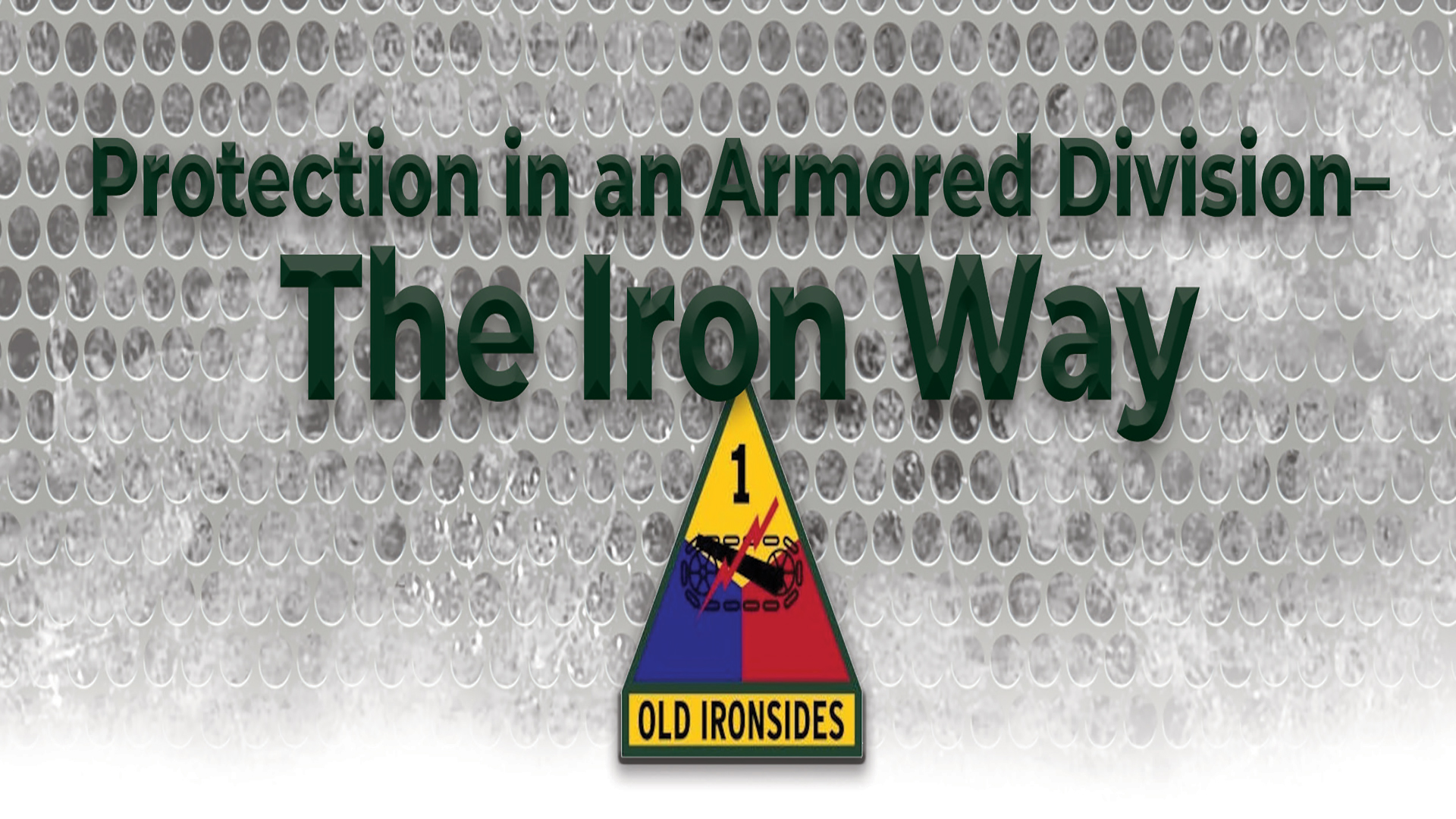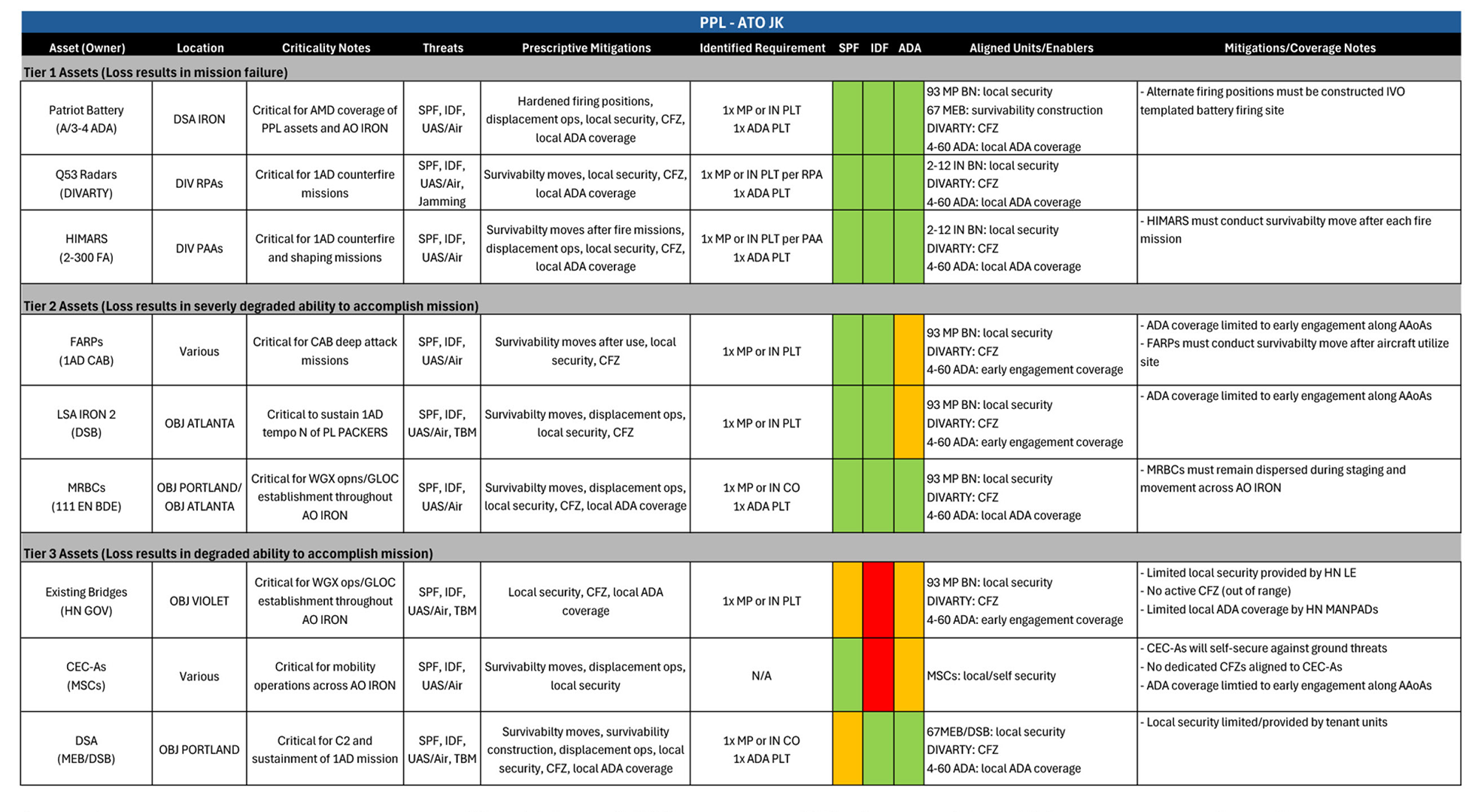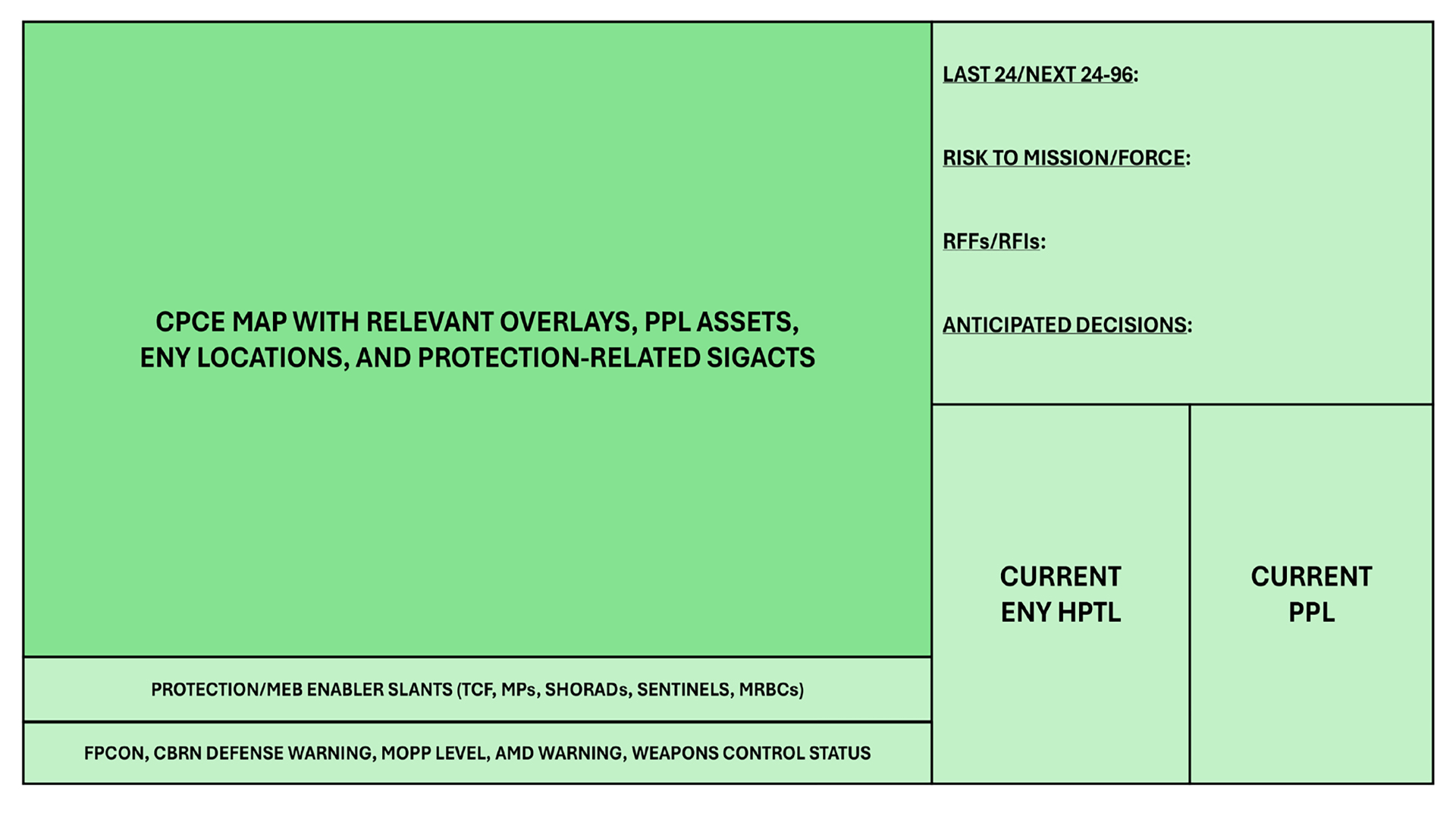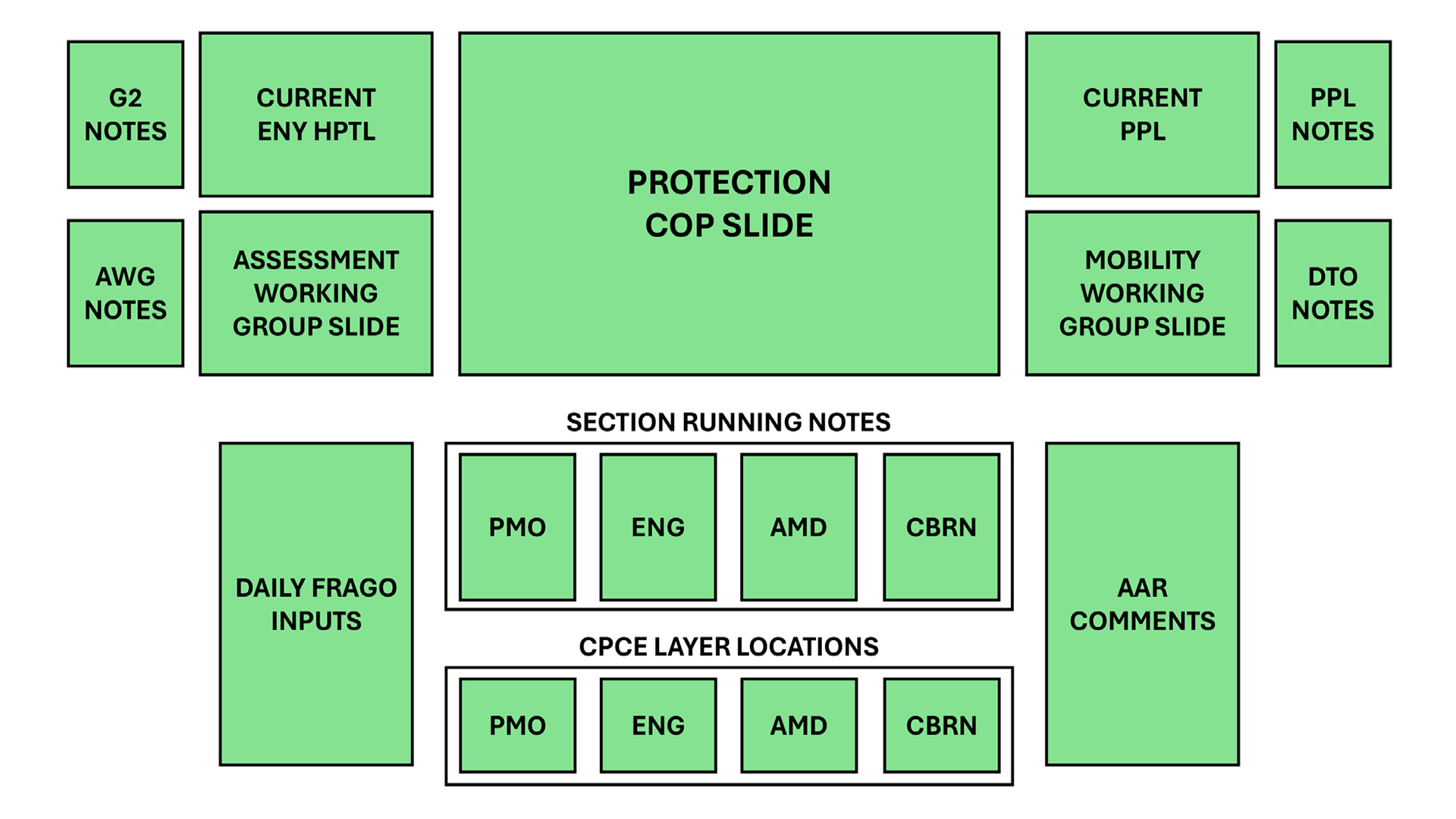Protection in an Armored Division- The Iron Way
By Major Luke J. Grieder
Article published on: February 2nd 2025, in the 2025 Protection E-Edition
Read Time: < 7 mins

Joint Publication (JP) 3-0, Joint Operations, defines protection as the “preservation of the effectiveness and survivability of mission-related military and nonmilitary personnel, equipment, facilities, information, and infrastructure deployed or located within or outside the boundaries of a given operational area.”1 While this definition seems straightforward, effectively planning and executing the numerous tasks associated with the protection warfighting function (WfF)—which requires the integration of various discrete WfFs—can be challenging. This article outlines how the 1st Armored Division (1AD), known as America’s Tank Division, approaches protection during large-scale combat operations. It also shares best practices that emerged from the preparation and execution of Warfighter Exercise (WFX) 25-1, conducted in October 2024.
“Converse of Targeting” Methodology
As one of the newest Army WfFs, protection needs to be better understood and adequately integrated into mission planning and execution across the force. A common issue that hinders protection from effectively preserving combat power and ensuring freedom of maneuver is that various protection-related branches—such as Military Police, Air Defense, Engineer, and Chemical—operate in isolated “silos of excellence.” Additionally, failure to properly integrate and synchronize other WfFs into protection planning efforts is also common and compounded by staffing constraints across multiple command nodes. Facing these challenges, the 1AD protection enterprise significantly modified its processes, procedures, and fighting products during the command post exercises (CPXs) leading up to WFX 25-1. Much of the change was initiated with the arrival of Major General Curtis D. Taylor, the current commanding general of 1AD
Upon taking command in July 2024, Major General Taylor provided initial guidance regarding each WfF—including a vision statement on protection within the division, in which he indicated that protection would be viewed as the converse of targeting and that the division Protection Working Group (PWG) would serve as a counter to the enemy’s Targeting Working Group. With this clear vision and a command-driven culture emphasizing protection planning, the 1AD protection cell worked diligently to enhance its approach to the PWG and development of the protection prioritization list (PPL). The protection enterprise was directed to base planning efforts from the perspective of the enemy, with a particular focus on the enemy’s high-payoff target list (HPTL). As demonstrated by 1AD during CPX I-III, adhering to this process provides a clear understanding of what the enemy is likely to target and highlights the collection and delivery methods the enemy may use against items on the HPTL. Additionally, this methodology enabled the 1AD protection enterprise to more effectively prioritize critical assets, prescribe tasks (such as survivability moves, dispersion efforts, and alternating of Q-53 radar queuing cycles), and align protection enablersor other capabilities to mitigate risk. The analytical outputswere codified in the air tasking order (ATO) cycle on PPLsand were subsequently updated or adjusted through dailyPWGs.
PWG Adjustments: Maintaining a 96-Hour Planning Horizon
During the CPX train-up for WFX 25-1, the 1AD protection enterprise faced challenges in maintaining a 96-hour planning horizon for critical tasks, such as making adjustments to the PPL, reallocating protection enablers, and conducting risk management analysis. To improve planning efficiency and focus within this 96-hour timeframe, the protection cell implemented significant changes to the PWG meeting agenda, the list of required attendees, and the assignments for briefings. Key revisions included the following:
- Opening the working group with a briefing by a divisionplans officer (G-5) focused on the division fight 96+ hoursout. This provided timely planning updates and set thetone for keeping the discussion focused on three to fourATOs out.
- Reordering the PPL discussion and analysis (by ATO),starting at 96 hours out and working backward to thecurrent fight. Staff analysis, discussion, and decisionsthat were focused on 96 hours out were prioritized andcaptured first.
- Preceding each PPL discussion (by ATO) with updatedenemy HPTL analysis provided by the intelligence officer (G-2). This improved the PPL discussion and analysis by providing critical updates to enemy HPTL items, targeting, tactics, patterns, and G-2 concerns. The continual reevaluation of the enemy HPTL within the 72-, 48-, and 24-hour windows was crucial to this effort, resulting ina more refined protection cell notion of enemy targetingobjectives.
- Reorganizing the briefing order by priority of protectionand reserving the final portion of the meeting for downtrace unit updates. This ensured that subordinate unitshad time to brief the protection enterprise, raise concerns, request additional enabler support, and providecritical input from their perspectives across the area ofoperations.
- Cutting all formal division staff briefing requirements,allowing only “by exception” critical updates pertinent to1AD protection efforts. This preserved valuable time forG-5 updates, PPL discussions, and downtrace unit briefings.
After implementing these changes to the PWG meeting agenda, the 1AD protection enterprise experienced significant improvements in several areas, including overall operational awareness, PPL discussion and analysis, synchronization with subordinate units, promptness of requests for additional forces, and time management during the working group meeting. Output was primarily concentrated on decisions that needed Deputy Commanding General–Support approval. This included decisions concerning PPL updates, recommendations for the dynamic retasking of enablers, and refined protection guidance that was published in the daily fragmentary order.
Revamping of the PPL Template
Throughout CPX I-III, the 1AD protection enterprise developed multiple iterations of a PPL template to enhance the prioritization of mission-critical assets and the threats and hazards associated with each asset. These updates incorporated aligned enablers or mitigations and assessments of residual risks. The revised versions of the PPL were tailored to meet specific requirements set forth by the division commander. The top items on the PPL were assigned three layers of protection to address ground, air, and indirect fire threats. To codify these threats and synchronize the enablers or mitigations for comprehensive coverage across all three protection layers, adjustments were made to the doctrinal PPL template that has historically been used by 1AD, as outlined in Army Doctrine Publication (ADP) 3-37,Protection.2
In the final PPL template, recognized as a best practice by the Mission Command Training Program during WFX 25-1, assets were organized into a three-tiered system based on their mission criticality (rather than using a simple 1–N priority list). (See Table 1.) Additionally, the format allowed for the identification of specific threats to each asset, presentation of a three-layer coverage status, and outline of specific units and tasks designed to mitigate risks through active and passive measures. The three tiers were—
- Tier 1 (Mission-critical): Loss of asset would result inmission failure. Assets receive prioritized resources tomitigate risk and cover all three layers of protection.
- Tier 2: Loss of asset would result in a severely degradedcapability to accomplish the mission. Assets have threelayers of protection to the greatest extent possible.
- Tier 3: Loss of asset would result in a degraded capability to accomplish the mission. Mission requirements/enabler availability determine the alignment of protection assets.
The transition to a tiered PPL with three-layer coverage status led to immediate positive outcomes. Specifically, it enhanced the prioritization of protection enablers, improved residual risk management, and facilitated asset movement between tiers. The tiered list presented division senior leaders with a clearer understanding of asset prioritization than the mere changing of numerical values would have. These modifications ultimately increased clarity and efficiency in discussions related to risk and enabler alignment and enabled the division to quickly capture changes and publish them in the daily fragmentary order.
Revision of the Protection Common Operating Picture
A significant revision implemented by the 1AD protection enterprise involved redesigning the division protection common operating picture. Utilizing the virtual joint operating center as the primary collaboration point, staff sections and essential entities related to the protection mission (G-2, division transportation officer, maneuver enhancement brigade) were provided with a dedicated space to share updates and products from various working groups. This information was consolidated into a comprehensive protection common operating picture slide, which displayed crucial details, including PPL changes, asset locations, enabler combat power, risks to the mission and forces, and significant activities related to protection. (See Tables 2 and 3.) The virtual joint operating center protection common operating picture streamlined communication across different command nodes and ensured that updated products were disseminated throughout the protection enterprise.
Changes to Rear Command Post Manning
Roster changes in the 1AD rear command post (RCP) significantly enhanced the ability of the protection enterprise to conduct effective PWGs and synchronize protection efforts across various WfFs. Increased representation from the division staff, including the division sustainment brigade, G-2, operations (G-3), air cell, fires cell, and G-5, improvedWfF integration and facilitated more effective PPL analysisduring the PWG, regardless of operational tempo or virtualcommunication challenges. This expanded staffing capacity allowed greater focus on incorporating protection intofuture operations planning at the RCP and division headquarters. Additionally, the increased representation fromthe maneuver enhancement brigade, including more operations planners, liaison officers, and air defense personnel,improved coordination of enabler support for the PPL and rear area security operations. An additoinal benefit of these staffing changes included the battle tracking and planning capacity necessary for the RCP to assume command of division operations for short periods as the mission required.

Legend:
| Dedicated Coverage | |
| Limited Coverage | |
| No Dedicated Coverage | |
1AD—1st Armored Division
AAoA— aerial avenue of approach
ADA—air-defense artillery
AMD—air and missile defense
AO—area of operation
As—armored
ATO—air tasking order
BDE—brigade
BN—battalion
C2—command and control
CAB—combat aviation brigade
CEC—combat engineer company
CFZ—critical friendly zone
CO—company
DIV—division
DIVARTY—division artillery
DSA—division support area
DSB—division sustainment brigade
EN—engineer
FARP—forward arming and refueling point
GLOC—ground line of communication
GOV—government
HIMARS—high-mobility artillery rocket system
HN— host nation
IDF—indirect fire
IN—infantry
IVO—in vicinity of
LE—law enforcement
LSA—logistical support area
MANPAD—man-portable air defense
MEB—maneuver enhancement brigade
MP—military police
MRBC—multirole bridge company
MSC—major subordinate command
N—north
N/A—not applicable
OBJ—objective
ops—operations
PAA—position area for artillery
PL—phase line
PLT—platoon
PPL—protection prioritization list
RPA—radar position for artillery
SPF—special-purpose forces
TBM—theater ballistic missile
UAS—unmanned aerial system
WGX—wet-gap crossing

Table 2. 1AD Protection COP Template
Legend:
1AD—1st Armored Division
AMD—air and missile defense
CBRN—chemical, biological, radiological, and nuclear
COP—common operating picture
CPCE—command post computing environment
ENY—enemy
FPCON—force protection condition
HPTL—high-payoff target list
MEB—maneuver enhancement brigade
MOPP—mission-oriented protective posture
MP—military police
MRBC—multirole bridge company
PPL—protection prioritization list
RFF—request for forces
RFI—request for information
SHORAD—short-range air defense
SIGACT—significant activity
TCF—tactical combat force

Table 3. 1AD Protection COP Template
1AD—1st Armored Division
AAR – After Action Review
AMD – Air & Missile Defense
AWG – Assessment Working Group
CBRN – Chemical, Biological, Radiological, Nuclear
COP – Common Operating Picture
CPCE – Command Post Computing Environment
DTO – Division Transportation Officer
ENG – Engineer
ENY – Enemy
FRAGO – Fragmentary Order
HPTL – High Payoff Target List
PMO – Provost Marshal Office
PPL – Protection Prioritization List
VJOC – Virtual Joint Operating Center
Offensive protection operations in the rear area constituted another added benefit of the RCP manning restructure. With the addition of a dedicated fires cell and an increase in maneuver enhancement brigade representation, operations aimed at targeting special-purpose forces behind the forward line of own troops became more synchronized and deliberate, bolstering efforts to protect critical assets and logistical nodes/operations throughout the rear area. The efficiency of offensive protection operations became especially important during the final phases of WFX 25-1, where the 1AD rear area and ground lines of communication far exceeded the doctrinal security capabilities of the attached maneuver enhancement brigade. The RCP manning changes enabled the 1AD protection enterprise to better integrate collection activities with tactical combat force and military police units across the rear to locate and disrupt special-purpose forces operations targeting PPL assets, command nodes, and critical sustainment operations.
Conclusion
Given the current events in Europe and the range of threats from the strategic support area to the division battlespace, the importance of protection is increasing. Protection requires thorough integration across all WfFs. Through its “Converse of Targeting” methodology, updates to the PWG agenda, and improvements in fighting products, the 1AD protection enterprise succeeded during WFX 25-1. Furthermore, the 1AD protection enterprise found that enhancing the clarity and conciseness of protection-related products prompted leaders from other WfFs to be more willing to allocate additional personnel, resources, and time to address the challenges. By sharing best practices from 1AD, units preparing for their WFXs or deployments can continue to improve their protection efforts, helping to preserve combat power and mitigate threats to their respective formations.
Endnotes
1. 1JP 3-0, Joint Campaigns and Operations, 18 June 2022.
2. 2ADP 3-37, Protection, 31 July 2019.
Author
Major Grieder is the Deputy Provost Marshal, 1AD, Fort Bliss, Texas. During WFX 25-01, he served as the lead military police planner and protection integrator at the 1AD RCP. He holds a bachelor’s degree in criminal justice from Texas State University, San Marcos; a master’s degree in business and organizational security management from Webster University; and a master of operational studies degree from the U.S. Army Command and General Staff College, Fort Leavenworth, Kansas.